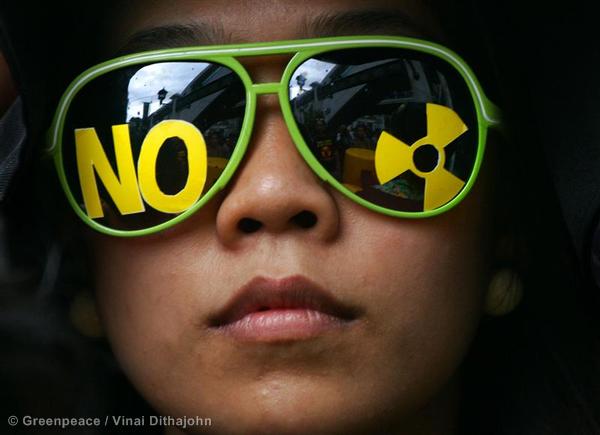This article was originally published in the Miami Herald and is co-authored by Annie Leonard, Executive Director, Greenpeace USA; Michael Brune, Executive Director, Sierra Club; and Erich Pica, President, Friends of the Earth.
More than seven out of ten of us want more emphasis on wind and solar energy, while only about a third favor more nuclear energy, according to the latest research from the Gallup poling organization. Gallup also found that support for nuclear power dropped by 11 percentage points in the United States in the last five years.
Meanwhile, the struggling nuclear industry is trying to pitch its product as a viable low-carbon alternative to clean energy, rather than the dangerous and expensive choice that it is.
As potential climate solutions go, though, nuclear power is a losing proposition that is only getting worse. Developing clean, affordable renewable energy sources and tapping our vast energy efficiency “reserves” is a much smarter bet for America’s future.
As things now stand, the nuclear power industry is facing dark days. All five nuclear reactors now under construction in the United States are behind schedule and billions of dollars over budget—a situation that is not unique to our nation. In fact, 75 percent of reactors currently under construction worldwide are delayed and over budget.
In Illinois, the utility Exelon is pressing state lawmakers for a massive bailout to keep its existing fleet of reactors online because they cannot compete in the marketplace. Similar bailout schemes are in front of regulators in Ohio and New York State. In the past two years, nuclear reactors have been shut down in Vermont, Wisconsin, and California, while plans for nine new reactors have been scuttled.
Contrast the nuclear power industry’s troubles with the bright prospects for renewables and energy efficiency, and it’s clear that our future lies not with the unstable nuclear industry but with the rapidly growing clean energy sector.
The cost of solar panels has fallen dramatically—80 percent in the past six years alone—and Wall Street projects that solar power will become even more price competitive. The United States produces enough solar energy to power 3.2 million homes, and that number is growing rapidly. Although nuclear power’s growth has been stagnant, the solar industry is adding jobs 20 times faster than the rest of the economy. Twice as many Americans are now employed in the solar power industry as in coal mining.
Wind power is already one of America’s most affordable energy sources, with nearly 50,000 turbines providing electricity sufficient to power 15.5 million homes. Some states already get a quarter of their power from wind energy. In fact, there are markets where the extraordinarily low cost of wind power has led the nuclear industry to demand preferential pricing arrangements in an attempt to remain “competitive”.
Energy efficiency remains the nation’s least expensive and most climate-friendly approach to meeting our energy needs. According to the American Council for an Energy-Efficient Economy, the American economy has tripled in size since 1970, and three-quarters of the energy required to fuel that growth came from energy-efficiency and related advances—not from new nuclear reactors or fossil fuels.
Contrast that with the drawbacks of nuclear power, which are substantial and all too well documented.
Increasingly severe natural disasters (including earthquakes, floods, and Fukushima-style tsunamis), the inevitability of design and operator errors, and the threat of terrorist attacks pose special dangers for nuclear reactors and the communities that exist alongside them. Add to that the lack of a permanent, proven, and safe solution for the isolation of highly-radioactive nuclear waste, which will be hazardous for hundreds of thousands of years, and it’s clear that nuclear power fails to make the grade.
The nuclear industry and its paid advocates often try to brush off these problems by noting that they favor yet-to-be-developed nuclear reactor technologies. But this is a weak argument given that we’re already seeing the effects of climate change in our backyards and around the globe.
By definition, so called “advanced” nuclear reactor technologies still under development—including “small modular reactors” or proliferation-prone plutonium “breeder” reactors—are unproven, most likely uneconomical (based on the industry’s track record), decades away from commercial use, and not assured of regulatory approval. To pin our hopes on future nuclear technology breakthroughs—at the very point that the broad scientific consensus says that the tipping point of climate change is already upon us—would be rash indeed.
In fact, Wall Street and industry analysts have pronounced the old-fashioned “baseload” system of nuclear reactors and other large power stations to be a dying relic of the 20th century. Just as “snail mail” has been largely replaced by email, the old-style energy grid in this nation already is giving way to decentralized, distributed power solutions, with a smarter, tech-savvy reliance on renewables, energy efficiency, and battery-storage technology, including the recently announced Tesla battery solution for homes, businesses and utilities.
Much like the coal industry, nuclear-dominated utilities are fighting to maintain their current and lucrative business model—but the way we power America already has begun an inevitable and essential transformation. Progress may be impeded by reactor and utility bailouts for a time, to the detriment of everyone else and the climate, but it cannot and will not be stymied for long.



